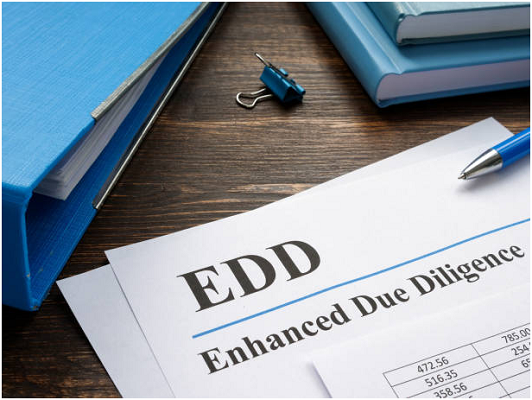Know Your Customer (KYC) and Anti Money Laundering (AML) compliances take up most of the processes in financial institutions. As the names suggest, these regulations ensure that banking institutions are verifying the identities of their customers and their transaction patterns. Customer Due Diligence (CDD) and Enhanced Due Diligence (EDD) are two processes to ensure KYC AML compliance.
This blog discovers how an institution can stay ahead of the EDD compliance process by implementing effective ways for cost reduction and mitigation of risk.
EDD Compliance Overview
Here’s a brief overview of the people and companies that fall under the EDD compliance category:
1. Politically Exposed Persons (PEPs)
2. Ultimate Beneficial Owners (UBOs)
3. Shell corporations
4. Companies or individuals in high-risk/FATF-blocked countries
This list is by no means exhaustive, however, the restrictions applied on the banking companies introduce a significant workload. For multinational corporations, compliance might not be that big of an issue. However, digital banks with limited resources may struggle to keep up with the ever-evolving realm of regulatory compliance. Given the high costs of implementing and maintaining risk assessment and KYC due diligence systems, banks need to look towards digital solutions.
The Requirements and Challenges for EDD Compliance
Financial Action Task Force (FATF) and AML Policies outline the requirements for risk assessments of clients. To provide a summary, FATF allows the institutions to create categories depending on the risk of each person. For instance, an initial assessment of all customers may bring forth evidence of their involvement in illegal transactions or practices. If they are not related to any such wrongdoings, the client is whitelisted. However, if the assessment shows any risk based on location, authority, value, or business risk, they have to go undergo an EDD process. This enhanced due diligence AML exercise will further determine the status of the client.
The Language Pitfall
The very first practice that distinguishes a robust EDD compliance system from a weaker one is its language understanding. Whether the EDD banking team comprises human resources or even if it is a digital solution, the performance will be weak if it cannot comprehend languages other than English. The basic hurdle for small in-house teams is that they cannot keep up with the language understanding demand of the documents. In short, EDD can require the assessment of documents in multiple languages. This can become a huge problem in the long term if the resources cannot keep up with the workload. Therefore, effective practice is to implement an enhanced due diligence system that can automatically understand documents in different languages.
Access to Knowledge
Another issue that can plague a small in-house team is the constantly changing regulation of the compliance authorities. For instance, governments can have their own set of rules upon the already present laws by FATF and KYC AML compliance policies. EDD compliance depends on the quick and accurate assessments of the relations and transactions of entities. Therefore, if the team lags, the work can stack up in the backlog. This is neither favourable for the clients nor for the banking institutions themselves. As a solution, the implementation strategy should include a robust system that can store and access continuously changing databases. Moreover, it should comply with the evolving global regulations as well.
Accuracy in Assessment
Building on the previous points, with the abundance of documents in different languages and the plethora of knowledge available in online databases, it can be quite hard for a team to make accurate assessments. Moreover, instead of individual document checking, EDD processes normally constitute cross-checking with international sanction lists. Not only will it consume countless man-hours, but will also consume funds in the retrieval and upkeep of data in a manual way.
On the flip side, an automated system can do these processes with minimal human intervention. Moreover, the accuracy of such an EDD compliance system exceeds human assessment as there can be no errors in entries.
Data Accessibility and Security Compliances
Even if the KYC AML compliance team adjusts to the language and easily-accessible knowledge pitfalls, data accessibility can be an obstacle in the long run. Firstly, certain high-risk locations have dangerously flexible tax regulations. Some locations do not even need the names of shareholders during the setting up of a company. This poses a serious issue in EDD compliance. In such cases, a state-of-the-art system can prove beneficial to the company as well as its clients.
Final Words on Implementing EDD Banking
To sum it up, EDD compliance is now more than just a regulatory requirement. Enhanced due diligence has now become a crucial part of the banking reputation. Therefore, any institution that delves into finance should now implement a system that complies with these regulations. Moreover, the EDD compliance system should be flexible and modular enough to learn as the compliance regulations keep changing in different regions of the world.


